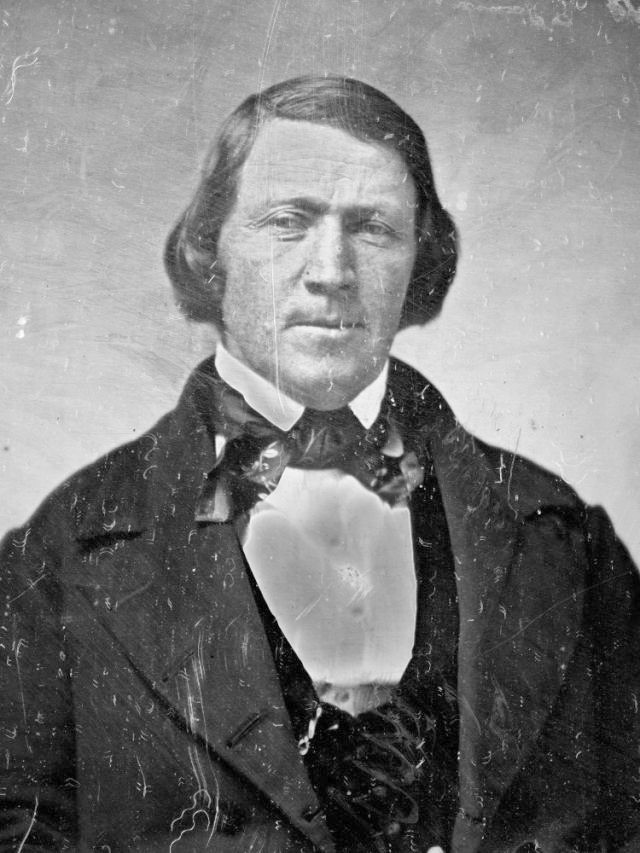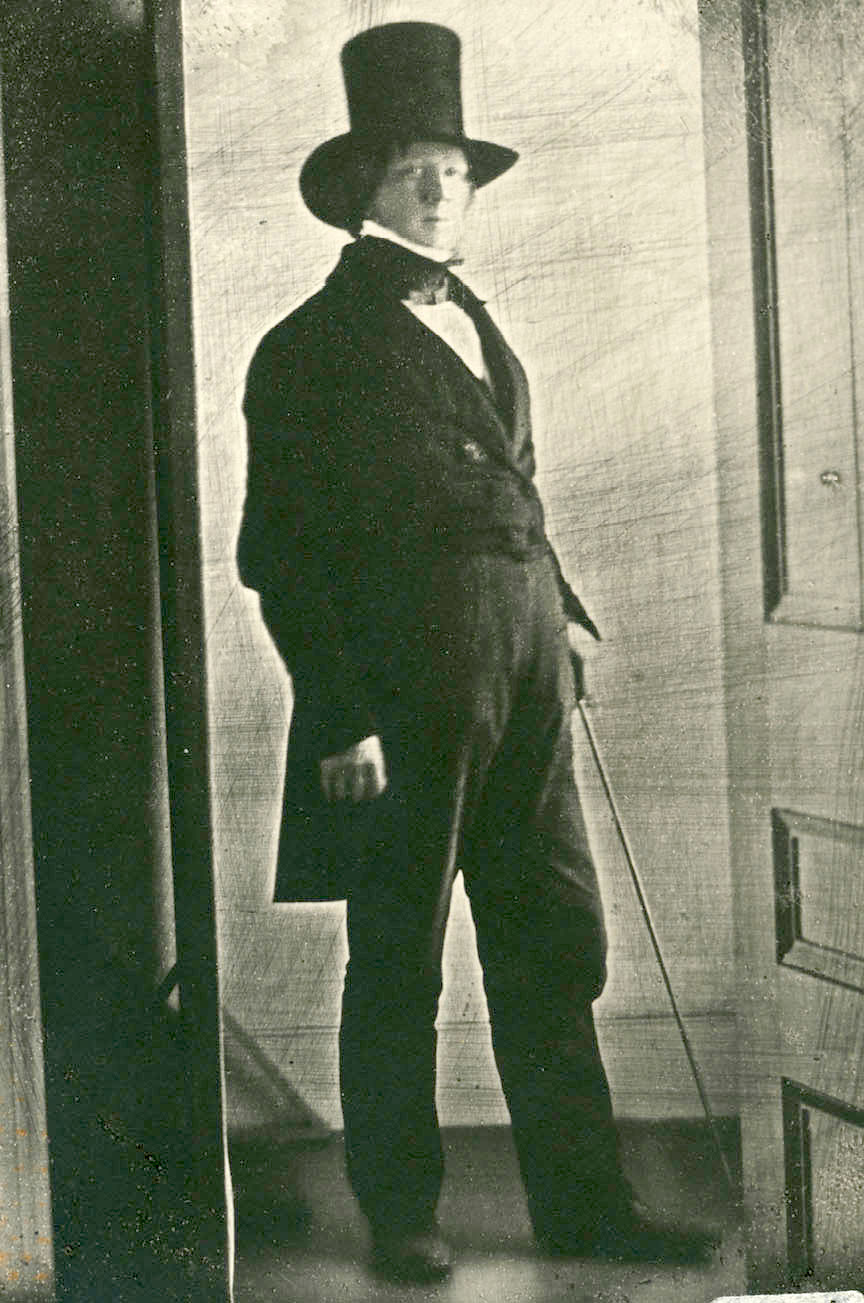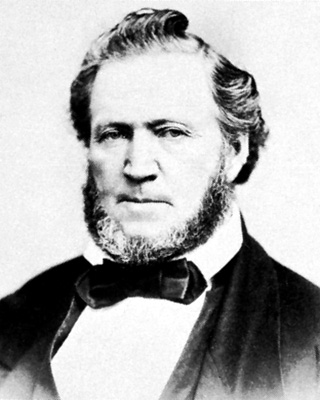Brigham Young
(1801-1877)



By Susan Easton Black
Few men of the nineteenth century matched the tenacity and determination of Brigham. Reading the Book of Mormon brought answers to his search for truth. He said,
When I saw a man without eloquence, or talents for public speaking, who could only say, “I know, by the power of the Holy Ghost, that the Book of Mormon is true, that Joseph Smith is a Prophet of the Lord,” the Holy Ghost proceeding from that individual illuminated my understanding, and light, glory, and immortality were before me.1
Anxious to meet the translator of the Book of Mormon, Brigham journeyed from New York to Kirtland, Ohio. “When I went to Kirtland I had not a coat in the world,” he recalled. “Neither had I a shoe to my feet, and I had to borrow a pair of pants and a pair of boots.”2 Of meeting Joseph Smith, Brigham recalled, “Here my joy was full at the privilege of shaking the hand of the Prophet of God, and receiving the sure testimony, by the spirit of prophecy, that he was all that any man could believe him to be as a true Prophet.”3
Brigham served missions and defended Joseph against persecutors no matter the personal inconvenience. When overhearing a man loudly rail against the Prophet one night, he didn’t hesitate to jump in the fray:
I put my pants and shoes on, took my cowhide, went out, and laying hold on him, jerked him round, and assured him that if he did not stop his noise and let the people enjoy their sleep without interruption, I would cowhide him on the spot, for we had the Lord’s Prophet right here, and we did not want the devil’s prophet yelling round the streets. The nuisance was forthwith abated.4
To the faithful, Brigham was a compassionate friend. Witnessing Mary Pitt being carried to her baptism, he gave her a blessing to rebuke “her lameness in the name of the Lord, and commanded her to arise and walk. The lameness left her, and she never afterwards used a staff or crutch.”5 Brigham marveled at the healing and the miracle of thousands of British converts who embraced the Gospel of Jesus Christ: “It truly seemed a miracle . . . We landed in the spring of 1840, as strangers in a strange land and penniless. But through the mercy of God we have gained many friends, established churches and have left sown in the hearts of many thousands the seeds of eternal truth.”6
Brigham’s darkest day was on June 27, 1844, the day the Prophet Joseph was killed in Carthage. Brigham wrote, “Spent the day in Boston with brother Woodruff . . . In the evening, while sitting in the depot waiting, I felt a heavy depression of Spirit, and so melancholy I could not converse with any degree of pleasure. I could not assign my reasons for my peculiar feelings.”7 Twelve days later he learned the reason for his heavy depression: “The first thing I thought of was whether Joseph had taken the keys of the kingdom with him from the earth. Bringing my hand down on my knee, I said, ‘The keys of the kingdom are right here with the Church.’”8
When he returned to Nauvoo, Brigham declared, “The Twelve are appointed by the finger of God . . . an independent body who have the keys of the priesthood—the keys of the kingdom of God to deliver to all the world.”9 His authority was challenged by Sidney Rigdon and others. With characteristic steadfastness, Brigham met the challenges and moved forward the work of God. He encouraged Latter-day Saints to finish the Nauvoo Temple and prepare to move west. Beginning in February 1846 Latter-day Saints abandoned their homes for the unchartered West. Under Brigham’s prophetic guidance, they crossed the plains to the Rocky Mountains and established hundreds of settlements. Brigham said,
It has been asked if we intend to settle more valleys. Why certainly we expect to fill the next valley and then the next, and the next, and so on. It has been the cry of late, through the columns of the newspapers that the “Mormons” are going into Mexico! That is quite right, we calculate to go there. Are we going back to Jackson County? Yes. When? As soon as the way opens up. We intend to hold our own here, and also penetrate the north and the south, the east and the west, there to make others and to raise the ensign of truth. We will continue to grow, to increase and spread abroad, and the powers of earth and hell combined cannot hinder it.10
Brigham Young died in August 1877 in Salt Lake City at age 76.
1. Brigham Young, “March of ‘Mormonism,’ etc.,” Journal of Discourses 26 vols. (Liverpool: Latter-Day Saint Depot, 1855), 1:90.
2. Brigham Young, “Saints Subject to Temptation, etc.,” Journal of Discourses, 2:128.
3. “History of Brigham Young,” Millennial Star (July 1863), p. 439.
4. Elden Jay Watson, ed., Manuscript History of Brigham Young, 1801-1844 (Salt Lake City: Elden Jay Watson, 1968), pp. 17-18.
5. Matthias F. Cowley, Wilford Woodruff, History of His Life and Labors (Salt Lake City: Bookcraft, 1964), p. 120.
6. Manuscript History of Brigham Young, 1801-1844, p. 61.
7. Ibid., p. 169.
8. James R. Clark, comp., Messages of the First Presidency 6 vols. (Salt Lake City: Bookcraft, 1965-1975) 1:233.
9. Edward William Tullidge, Life of Brigham Young: Or, Utah and Her Founders (NY: Tullidge & Crandall, 1876), p. 112.
10. Brigham Young, “The United Order, etc.,” Journal of Discourses, 18:355-556.
